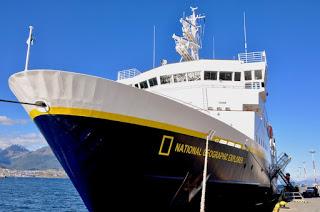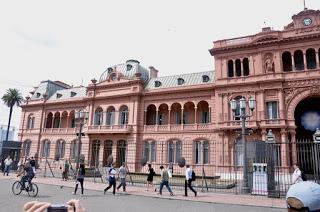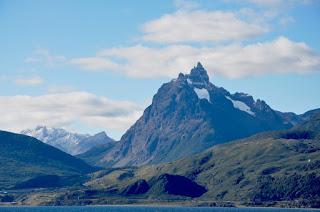 This past March I had the opportunity to visit a part of the world that I never thought I'd see. I spent three weeks aboard the National Geographic Explorer traveling with Lindblad Expeditions on their journey to the Falkland Islands and South Georgia, which many of you know holds a hallowed place in the history of polar exploration. While on that trip I was on assignment for Popular Mechanics, and after I came home I wrote this story about my travels. But, I haven't really shared my experience with readers here at The Adventure Blog as I typically do after a long trip. I hope to change that with a series of stories about what it is like to travel by ship through the Southern Ocean. Perhaps I'll inspire a few others to make the journey along the way, because if you're an adventurous traveler at all, you'll want to have this corner of the planet on your bucket list.
This past March I had the opportunity to visit a part of the world that I never thought I'd see. I spent three weeks aboard the National Geographic Explorer traveling with Lindblad Expeditions on their journey to the Falkland Islands and South Georgia, which many of you know holds a hallowed place in the history of polar exploration. While on that trip I was on assignment for Popular Mechanics, and after I came home I wrote this story about my travels. But, I haven't really shared my experience with readers here at The Adventure Blog as I typically do after a long trip. I hope to change that with a series of stories about what it is like to travel by ship through the Southern Ocean. Perhaps I'll inspire a few others to make the journey along the way, because if you're an adventurous traveler at all, you'll want to have this corner of the planet on your bucket list.My journey began by first flying from my home in Nashville, TN to Buenos Aires, Argentina. I always appreciate when I'm traveling to South America, because it is relatively hassle free and you don't cross many timezones coming or going, which eliminates jet lag entirely. Still, it was an overnight flight from Miami to BA, and I don't tend to sleep particularly well on a flight. Still, arriving in Argentina the following morning I was surprisingly refreshed and ready to go.
The first day of the trip was actually spent in Buenos Aires, where the Lindblad staff met everyone, issued us a welcome packet, and provided us with some information about what we could expect before, during, and after the voyage. The entire process was extremely well organized and well handled, making it as easy as possible for the travelers, many of which were tired from long flight and ready for a bit of rest.
But, this would also be our only day in BA, which is one of the most cosmopolitan cities in all of South America. To take advantage of this, Lindblad organized a city tour for the afternoon, with those of us with the energy setting out to tour the area. We spent several hours visiting a variety of parts of town, including the Plaza de la República, the Beaux Arts Palaces, and the so-called Pink House, which was the seat of government in Argentina for hundreds of years. It was there that Evita Peron stepped out onto the balcony in what is now a very famous historical scene.
 While on the tour we made several stops, allowing us to wander about and take in the culture. At one stop, we strolled through sidewalk cafes where wonderful smells of local dishes wafted through the air. We also witnessed couples dancing the tango, which is deeply seated in the culture of the country as well. Watching these expert dancers moving concert with one another amidst the colorful sights and sounds of Buenos Aires was certainly a highlight of the experience to say the least.
While on the tour we made several stops, allowing us to wander about and take in the culture. At one stop, we strolled through sidewalk cafes where wonderful smells of local dishes wafted through the air. We also witnessed couples dancing the tango, which is deeply seated in the culture of the country as well. Watching these expert dancers moving concert with one another amidst the colorful sights and sounds of Buenos Aires was certainly a highlight of the experience to say the least.The tour was over after a few hours and we returned to the hotel for a gathering before grabbing a quick dinner and turning in for the night. The following day would be a travel day once again, and it was definitely time to get some rest. After all, this adventure was really just getting started, even though we had only gotten the briefest of glances of what Buenos Aires has to offer. For me, it just reaffirmed what I already knew: I need to return to spend more time there.
The following day we were up and moving early. After a quick breakfast, we grabbed our bags and loaded up onto several large buses that would shuttle us to the nearby domestic airport to catch a flight to Ushuaia – the southernmost city in the world. It would be from there that we would depart on our journey by sea, but not before we had a few other experiences first.
The flight from BA to Ushuaia took more than three hours to complete, but when we landed it was like stepping out into another world altogether. Gone was the warm, muggy conditions of Argentina's capital city, replaced instead with crisp, cool, and clean air that is only found in more remote regions. The sky overhead was clear and we could see not only snowcapped peaks in the distance, but the sparkling waters of the Beagle Channel nearby as well. We were in the Patagonia region in southern South America, and the legendary beauty of the place was evident, even though we hadn't gone anywhere just yet.
 Again, we loaded up on buses and headed through town. Ushuaia looked like a charming village as we rolled through, but there was no time to stop. We would visit it again later on the trip, near the end of the journey, but for now we were off to other locales first.
Again, we loaded up on buses and headed through town. Ushuaia looked like a charming village as we rolled through, but there was no time to stop. We would visit it again later on the trip, near the end of the journey, but for now we were off to other locales first.We drove into Tierra del Fuego National Park where the remote and rugged nature of the area became more evident. Those snowcapped peaks continued to surround us, but we also passed through dense forests and around pristine lakes as we made our way even further south. While en route, we were told that the region was overrun with beavers, brought to Tierra del Fuego back in 1946 in an attempt to create a fur trade for local inhabitants. Those beavers had no natural predators however and soon grew in great numbers. Now, it is believed that more than 250,000 of them exist there and they are threatening the very existence of the forests. The Argentine government has announced plans to eradicate large numbers of them, but for now they are a true menace.
Passing through the park, we eventually drove to the end of the road – quite literally. At one point we stopped and exited the bus at a large sign that marked "Mile 0" of the Pan-Amarican Highway. There was no way to drive any further, so we took a short hike down a trail that ended at a dock where a twin-hulled boat waited to collect the entire group. Once on board, we set sail out into the Beagle Channel and enjoyed lunch as we explored the southernmost tip of the continent. Along the way, we spotted birds and seals, while drinking in the breathtaking scenery.
After lunch and a brief boat ride, we docked again in Ushuaia, where we simply moved from the boat to our ship. There, the National Geographic Explorer awaited us, and the real adventure was about to begin. Greeted by the crew, we filed onto the ship and made our way to our cabins. Within a matter of an hour or two, we would depart Ushuaia once again, but this time we wouldn't return for nearly three weeks.
Our next stop was the Falkland Islands a place that would live up to the hype and deliver even more than I had ever expected. More about that in the next installment of this series.

